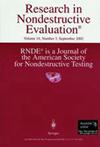Quantitative Evaluation of Corrosion Defects on Structural Steel Plates via Metal Magnetic Memory Method
IF 1.6
4区 材料科学
Q3 MATERIALS SCIENCE, CHARACTERIZATION & TESTING
引用次数: 0
Abstract
ABSTRACT The detection and evaluation of corrosion defects take on a critical significance to ensure the service safety of steel structures in civil engineering. The quantitative evaluation of corrosion defects has not been well addressed though metal magnetic memory (MMM) testing technology has been investigated in steel corrosion problems. In this study, the Q345qD steel plates were taken as the specimens of MMM testing. Specimens with different corrosion degrees were developed through electrochemical corrosion, and the change laws of the MMM signals and the characteristics of different corrosion specimens were analyzed. A three-dimensional (3D) magnetic charge model of the corrosion area was built based on the magnetic charge theory, such that the change laws of the MMM signal in the corrosion area from the mechanism were explained. The finite element simulation results of the corrosion specimens were well consistent with the experimental and theoretical results. A quantitative evaluation method for corrosion defect depth was proposed in combination with finite element simulation and experimental data. Comparing the experimental data and the inversion data, the relative errors of the determined defect depth h were within 20%, suggesting that the proposed evaluation method is feasible for the quantitative evaluation of steel corrosion depth.金属磁记忆法定量评价结构钢板腐蚀缺陷
摘要在土木工程中,腐蚀缺陷的检测与评价对保证钢结构的使用安全具有重要意义。金属磁记忆(MMM)检测技术在钢铁腐蚀问题中的研究尚未很好地解决腐蚀缺陷的定量评价问题。本研究以Q345qD钢板为试件进行MMM试验。通过电化学腐蚀对不同腐蚀程度的试样进行显影,分析不同腐蚀试样的MMM信号变化规律及特征。基于磁荷理论建立了腐蚀区域的三维磁荷模型,从机理上解释了腐蚀区域磁MMM信号的变化规律。腐蚀试样的有限元模拟结果与实验和理论结果吻合较好。结合有限元模拟和实验数据,提出了一种腐蚀缺陷深度的定量评价方法。对比实验数据和反演数据,所确定的缺陷深度h的相对误差在20%以内,表明所提出的评价方法对于钢材腐蚀深度的定量评价是可行的。
本文章由计算机程序翻译,如有差异,请以英文原文为准。
求助全文
约1分钟内获得全文
求助全文
来源期刊

Research in Nondestructive Evaluation
工程技术-材料科学:表征与测试
CiteScore
2.30
自引率
0.00%
发文量
14
审稿时长
>12 weeks
期刊介绍:
Research in Nondestructive Evaluation® is the archival research journal of the American Society for Nondestructive Testing, Inc. RNDE® contains the results of original research in all areas of nondestructive evaluation (NDE). The journal covers experimental and theoretical investigations dealing with the scientific and engineering bases of NDE, its measurement and methodology, and a wide range of applications to materials and structures that relate to the entire life cycle, from manufacture to use and retirement.
Illustrative topics include advances in the underlying science of acoustic, thermal, electrical, magnetic, optical and ionizing radiation techniques and their applications to NDE problems. These problems include the nondestructive characterization of a wide variety of material properties and their degradation in service, nonintrusive sensors for monitoring manufacturing and materials processes, new techniques and combinations of techniques for detecting and characterizing hidden discontinuities and distributed damage in materials, standardization concepts and quantitative approaches for advanced NDE techniques, and long-term continuous monitoring of structures and assemblies. Of particular interest is research which elucidates how to evaluate the effects of imperfect material condition, as quantified by nondestructive measurement, on the functional performance.
 求助内容:
求助内容: 应助结果提醒方式:
应助结果提醒方式:


